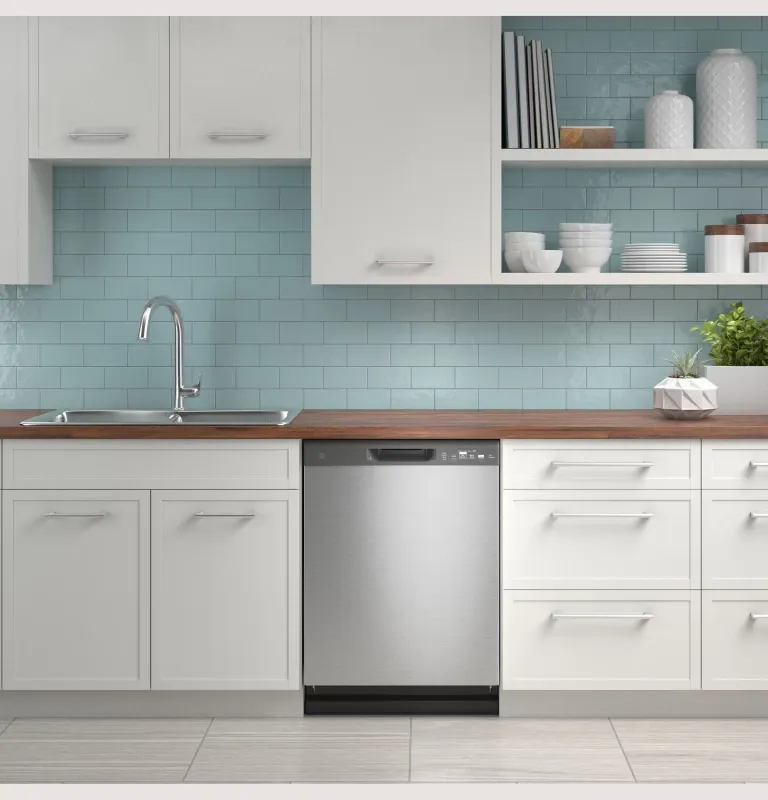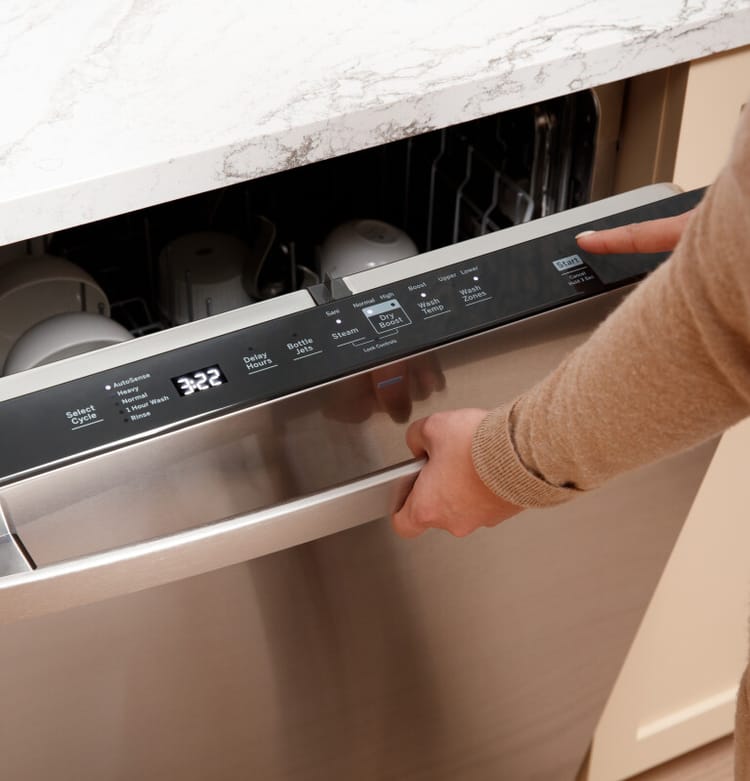How to Measure for a Dishwasher: Know Before You Buy

Accurate measurement is crucial for dishwasher installation to ensure a seamless fit and optimal performance. When it comes to adding a new dishwasher to your kitchen, taking precise measurements can prevent fitting issues, reduce installation headaches, and guarantee that your new appliance works efficiently. Proper measurements help avoid the hassle of returning a dishwasher that doesn’t fit and ensure that the installation process goes smoothly. In this guide, we will walk you through the essential steps and tips for measuring your space accurately for a new dishwasher. This will help you make an informed purchase and enjoy the convenience of your new kitchen appliance without any complications.
Tools Needed for Measuring a Dishwasher Space
To ensure you get the most accurate measurements for your dishwasher installation, you'll need a few key tools. Having these on hand will make the process smoother and help you avoid any potential issues down the line.
1. Tape Measure
A reliable tape measure is your primary tool. Choose one that measures in both inches and centimeters for versatility. Make sure it has clear markings and is easy to read.
2. Pencil and Paper or a Digital Note-Taking Device
Recording your measurements is crucial. Use a pencil and paper to jot down the dimensions, or opt for a digital note-taking device like a smartphone or tablet to store your notes electronically. This can be especially handy for keeping track of multiple measurements and for future reference.
3. Optional: Level
A level isn't strictly necessary but can be very useful. It ensures that your measurements are accurate and that the space where you plan to install the dishwasher is level. This is particularly important for proper dishwasher performance and to prevent water leaks.
4. Measuring Tape with Specific Increments
Using a measuring tape that includes increments like 1/8 or 1/16 inches can provide more precise measurements. This level of detail is helpful, especially when fitting appliances into tight spaces where every fraction of an inch counts.
Steps for Accurate Measurement
1. Measure the Width
Measure the distance between the cabinets where the dishwasher will be installed. Record the width at both the top and bottom of the opening to ensure accuracy. Use the smallest measurement if there is any discrepancy.
2. Measure the Depth
Measure from the back of the opening to the front. Ensure there's enough clearance for the dishwasher door to open fully. Typically, you need at least 27 inches of space in front of the dishwasher.
3. Measure the Height
Measure from the floor to the bottom of the countertop. Check the height at both the back and the front of the opening to accommodate any flooring variations. Most standard dishwashers require an opening that is 34 1/2 to 36 inches tall.
Understanding Dishwasher Types and Sizes
Selecting the right dishwasher for your kitchen starts with understanding the various types and sizes available. This ensures that you choose a model that fits perfectly in your space and meets your household's needs. Here’s a breakdown of the different dishwasher types and their standard dimensions.
Standard Built-In Dishwashers
Dimensions: Typically 24 inches wide, 35 inches high, and 24 inches deep.
Standard built-in dishwashers are the most common type found in modern kitchens. They are designed to fit under the kitchen countertop and between standard cabinetry. These models offer a balance of capacity and performance, making them suitable for most households.
Key Points:
- Fits into standard kitchen cabinets
- Offers ample space for family-sized loads
- Available in a variety of features and finishes
Compact Dishwashers
Dimensions: Usually 18 inches wide, with similar height and depth as standard models.
Compact dishwashers are ideal for smaller kitchens, such as those in apartments or older homes with limited space. Despite their smaller size, they often include many of the same features as their full-sized counterparts.
Key Points:
- Perfect for small kitchens or spaces
- Less capacity than standard models
- Can be built-in or portable
Oversized Dishwashers
Dimensions: Can range from 30 to 42 inches wide, maintaining the same height and depth as standard dishwashers.
Oversized dishwashers are designed for large households or those who entertain frequently. These models offer greater capacity, accommodating more dishes and larger items.
Key Points:
- Suitable for large families or frequent entertainers
- More interior space for dishes and cookware
- Requires a larger cutout space in cabinetry
Portable Dishwashers
Dimensions: Typically range from 18 to 24 inches wide, 36 to 37 inches tall, and 26 to 30 inches deep.
Portable dishwashers are an excellent solution for kitchens that cannot accommodate a built-in unit. These dishwashers can be moved and connected to the kitchen sink when in use and stored away when not needed.
Key Points:
- Flexible placement and storage
- Connects to the sink with a hose
- Ideal for renters or temporary setups
Countertop Dishwashers
Dimensions: Generally around 22 inches wide, 20 inches deep, and 17 inches tall.
Countertop dishwashers are compact and designed to sit on the kitchen counter. They are perfect for very small households or single individuals who need a dishwasher but lack the space for a larger model.
Key Points:
- Sits on the countertop
- Limited capacity, suitable for small loads
- Easy to install and use
Step-by-Step Guide to Measuring for a Dishwasher
Accurately measuring your space for a dishwasher is crucial for ensuring a smooth installation and optimal performance. Follow these steps to make sure your new appliance fits perfectly.
Step 1: Clear the Area: Ensure the Area is Free from Obstacles
Before you start measuring, clear the area where the dishwasher will be installed. Remove any existing appliances, cabinetry, or other obstacles that could interfere with taking precise measurements. This not only makes the process easier but also ensures that you get the most accurate dimensions.
A clutter-free workspace allows you to measure accurately without obstructions. Any objects left in the space can skew your measurements, leading to potential fitting issues when you install the dishwasher. Ensuring a clear area helps you avoid these problems and saves time during installation.
Step 2: Measure the Width
Measure Between the Cabinets
Using your tape measure, measure the distance between the cabinets where the dishwasher will be installed. Take this measurement at both the top and bottom of the opening to account for any variations. Record the smaller measurement if there is a discrepancy to ensure the dishwasher will fit properly.
Allow for Clearance
Make sure to leave a small gap on either side of the dishwasher to allow for easy installation and removal if necessary. This also helps with air circulation around the appliance, which can improve performance and longevity.
Step 3: Measure the Depth
Measure from the Back Wall to the Front Edge
Measure the depth of the space from the back wall to the front edge of the countertop or cabinetry. Ensure that this measurement includes enough room for the dishwasher door to open fully. You typically need at least 27 inches of clearance in front of the dishwasher to load and unload dishes comfortably.
Consider Obstructions
Take note of any pipes, electrical outlets, or other fixtures that could affect the depth measurement. Make sure these do not interfere with the dishwasher once installed.
Step 4: Measure the Height
Measure from Floor to Countertop
Measure the height from the floor to the underside of the countertop where the dishwasher will be installed. Take this measurement at both the front and back of the opening to account for any floor irregularities. Most standard dishwashers require a height of 34 1/2 to 36 inches.
Check for Levelness
Use a level to ensure that the floor is even. If there is a significant tilt, you may need to adjust the dishwasher’s leveling feet during installation to ensure proper alignment.
Additional Tips for Accurate Measurement
- Double-Check Measurements: Always measure twice to confirm accuracy.
- Record Measurements Precisely: Write down your measurements immediately to avoid confusion.
- Consider Flooring and Trim: If you plan to install new flooring or trim, account for these changes in your measurements.
Step 5: Account for Water and Electrical Connections
Proximity of Water Supply and Electrical Outlets
When measuring for your new dishwasher, consider the location of the water supply and electrical outlets. These connections need to be close enough to reach the dishwasher without stretching hoses or cords, which could cause leaks or electrical hazards. Ideally, the water supply should be within a few feet of the dishwasher’s location, and there should be an accessible electrical outlet nearby.
Importance of Easily Accessible Connections
Easily accessible water and electrical connections are crucial for both installation and maintenance. If connections are difficult to reach, it can complicate the installation process and make future repairs more challenging. Ensuring that these connections are easily accessible not only simplifies the initial setup but also makes it easier to service the dishwasher if needed.
Special Considerations
When measuring for a dishwasher, it’s important to consider different types of dishwashers, adapt to non-standard kitchen layouts, and closely follow the manufacturer’s installation instructions. These factors ensure a successful installation and long-term satisfaction with your appliance.
Measuring for Different Types of Dishwashers
Portable Dishwashers
Portable dishwashers are designed to be moved and typically connect to your kitchen faucet when in use. Measure the width, depth, and height of the storage area where the dishwasher will be kept when not in use, as well as the path it will travel to the sink. Ensure the dimensions allow for easy movement and connection to the water supply.
Countertop Dishwashers
Countertop dishwashers sit on your kitchen counter and are ideal for small kitchens. Measure the space on your countertop where the dishwasher will sit, including the distance from the top of the counter to the bottom of any overhead cabinets. This ensures the unit fits comfortably without interfering with existing kitchen fixtures.
Tips for Non-Standard Kitchen Layouts
Irregular Cabinet Openings
In kitchens with non-standard cabinet openings, it's crucial to take precise measurements of both the narrowest and widest points of the opening. Consider custom cabinetry adjustments if necessary to ensure a snug fit. Always opt for the smaller measurement to avoid issues with installation.
Uneven Floors
If your kitchen floor is uneven, it’s important to measure the height at multiple points—front, back, and sides. Use shims during installation to level the dishwasher, ensuring it operates correctly and prevents water leakage.
Obstructed Spaces
Take note of any potential obstructions such as pipes, electrical outlets, or protruding cabinet elements. These can affect the placement and installation of your dishwasher. Plan your measurements and installation steps around these obstacles to ensure a seamless fit.
Troubleshooting Common Measurement Issues
Even with careful planning and precise measurements, you might encounter some challenges when preparing your space for a new dishwasher. Here are some tips for handling common measurement issues to ensure a smooth installation process.
What to Do If Your Space Is Smaller or Larger Than Standard Sizes
If your kitchen space is narrower or shorter than the typical dimensions required for a standard dishwasher, consider the following solutions:
Compact Dishwashers
Opt for a compact dishwasher, which is typically 18 inches wide, compared to the standard 24 inches. These models are ideal for smaller spaces and still offer many of the features found in full-sized dishwashers.
Custom Cabinet Adjustments
If the space is only slightly smaller, you may be able to modify your cabinets or trim to create the necessary opening. Consulting with a professional carpenter can help you achieve a precise fit without compromising the integrity of your cabinetry.
Portable or Countertop Dishwashers
If modifying the space is not feasible, consider using a portable or countertop dishwasher. These models do not require built-in installation and can be moved or placed on the countertop, providing flexibility for smaller kitchens.
Space Larger Than Standard Sizes
For spaces that are wider or taller than the standard dishwasher dimensions:
Fillers and Trim Kits
Use fillers or trim kits to close any gaps between the dishwasher and the cabinets. These can be purchased in various sizes and finishes to match your kitchen decor and create a seamless look.
Oversized Dishwashers
Consider installing an oversized dishwasher if your kitchen can accommodate it. These models offer additional capacity, making them suitable for larger families or households that entertain frequently.
How to Adjust Measurements for Uneven Floors or Countertops
Uneven Floors
If your kitchen floor is uneven, this can affect the stability and alignment of your dishwasher. Here's how to address this issue:
Use Shims
Place shims under the dishwasher's feet to level the appliance. Shims are thin pieces of material that can be adjusted to different heights, helping to balance the dishwasher on an uneven floor.
Adjustable Feet
Many dishwashers come with adjustable feet that allow you to raise or lower each corner of the appliance. Use a level to check the alignment and make the necessary adjustments to ensure the dishwasher is balanced.
Uneven Countertops
Uneven countertops can cause the dishwasher door to misalign, affecting its ability to close properly and seal correctly.
Measure Multiple Points
Measure the height at multiple points along the countertop to determine the degree of unevenness. This will help you understand where adjustments are needed.
Adjust Dishwasher Height
Similar to dealing with uneven floors, use the dishwasher’s adjustable feet to balance the appliance under an uneven countertop. Ensure the top of the dishwasher is flush with the underside of the countertop to maintain a proper seal when the door is closed.
You’re Ready For Your New Dishwasher
Measuring for a dishwasher may seem like a daunting task, but with the right tools and a bit of patience, it can be straightforward and stress-free. By following the steps outlined in this guide, you ensure that your new dishwasher will fit perfectly into your kitchen space, avoiding any installation headaches. With precise measurements, you'll be well on your way to enjoying the convenience and efficiency of a new dishwasher in no time.
When you're ready, visit Slyman Bros Appliance store in St. Louis. We'll help you find the perfect dishwasher based on your measurements and needs.



